#cryptogyps
Text

ITS TIME
FOR
DINOSAUR MARCH MADNESS 2k23!!!!!!!!!!!!
Starting NEXT WEEK, we begin the ultimate competition:
DMM: RISING STARS
These are ALL dinosaurs that have been discovered in the past five years!!! New friends from old times!!! Including such new fan favorites as Bajadasaurus, Jakapil, Meraxes, and Anachronornis - and that's only four of them!
From the weird to the wonderful, these dinosaurs are here to indicate that just because they were found recently, doesn't mean that they aren't destined to become icons like the names we already know and love. Get ready to learn about some new paleontological excitement - and debate angrily over which ones are better ;)
Round One will go from March 1st through the 7th
Round Two will extend from March 8th through the 14th
Round Three will then go from the 15th to the 21st
Round Four from the 22nd to the 28th
And the FINAL FOUR SHOWDOWN (Ornithischian Vs Sauropodomorph vs Nonavian theropod vs Bird) will occur from March 29th through April 4th!
Thanks to the new tumblr poll feature, reconstructions and mini factfiles for each dinosaur will be on the post with the poll itself! No need to leave tumblr, no personal research, no google quizzes - just rapid learning and immediate voting!
Get ready to vote! Get ready to debate! Get ready... for DINOSAUR MARCH MADNESS!
Round One Matchups under the readmore :)
SAUROPODOMORPHA (and miscellany)
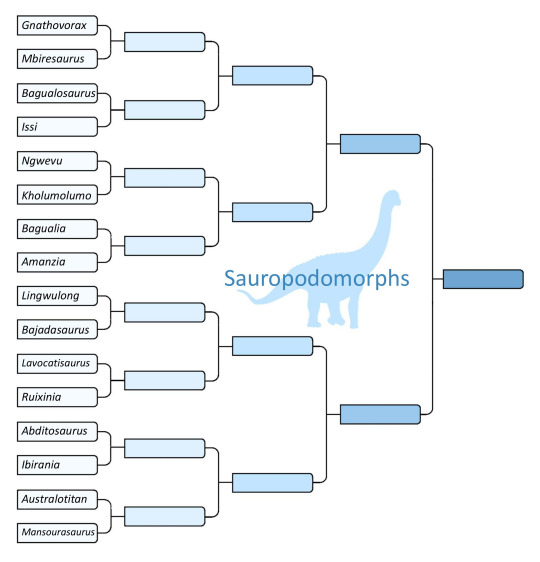
Gnathovorax vs Mbiresaurus
Bagualosaurus vs Issi
Ngwevu vs Kholumolumo
Bagualia vs Amanzia
Lingwulong vs Bajadasaurus
Lavocatisaurus vs Ruixinia
Abditosaurus vs Ibirania
Australotitan vs Mansourasaurus
ORNITHISCHIA
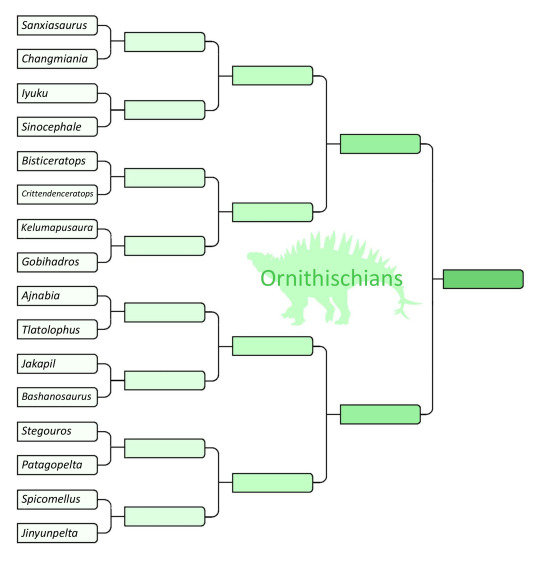
Sanxiasaurus vs Changmiania
Iyuku vs Sinocephale
Bisticeratops vs Crittendenceratops
Kelumapusaura vs Gobihadros
Ajnabia vs Tlatolophus
Jakapil vs Bashanosaurus
Stegouros vs Patagopelta
Spicomellus vs Jinyunpelta
NONAVIAN THEROPODA
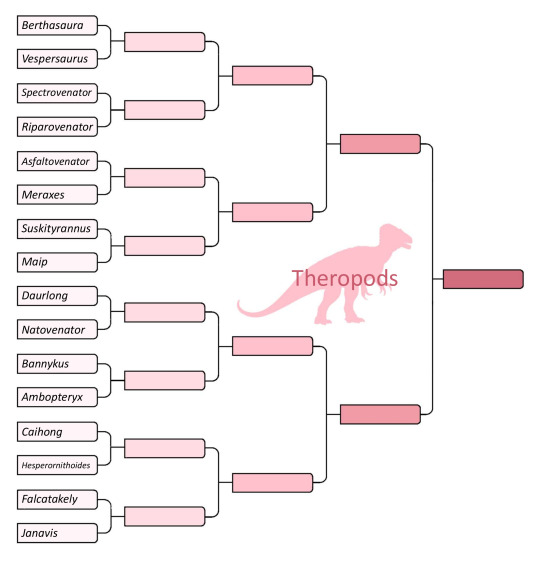
Berthasaura vs Vespersaurus
Spectrovenator vs Riparovenator
Asfaltovenator vs Meraxes
Suskityrannus vs Maip
Daurlong vs Natovenator
Bannykus vs Ambopteryx
Caihong vs Hesperornithoides
Falcatakely vs Janavis
NEORNITHES (BIRDS)

Vorombe vs Prodontopteryx
Asteriornis vs Panraogallus
Anachronornis vs Conflicto
Annakacygna vs Nasidytes
Aviraptor vs Cryptogyps
Miosurnia vs Primoptynx
Danielsraptor vs Heracles
Eofringillirostrum vs Heliothraupis
#dinosaur march madness#dmm#dmm rising stars#palaeoblr#dinosaurs#bracket#polls#march madness#tumblr dinosaur competition#thank you tumblr for making polls dmm is so much easier now I will cry#heliothraupis#eofringillirostrum#heracles#danielsraptor#primoptynx#miosurnia#cryptogyps#aviraptor#nasidytes#annakacygna#conflicto#anachronornis#panraogallus#asteriornis#prodontopteryx#vorombe#janavis#falcatakely#hesperornithoides#caihong
835 notes
·
View notes
Text
Cryptogyps Mather et al., 2022 (new genus)

(Partial humeri of Cryptogyps lacertosus [scale bar = 10 mm], from Mather et al., 2022)
Meaning of name: Cryptogyps = hidden vulture [in Greek]
Species included: C. lacertosus (type species, previously in Taphaetus)
Age: Pleistocene (Chibanian–Late Pleistocene)
Where found: Katipiri Formation, South Australia, Australia; Leaena's Breath Cave, Western Australia, Australia; and Wellington Caves, New South Wales, Australia
Notes: Cryptogyps lacertosus was a bird of prey, originally described based on a partial humerus (upper arm bone) as part of the genus Taphaetus. The name Taphaetus was originally used for a different fossil raptor (T. brachialis), which is now considered to be a member of the extant eagle genus Aquila, and likely the same species as the wedge-tailed eagle (Aquila audax) that still lives in Australia today. The relationships of “T.” lacertosus to modern raptors, on the other hand, have remained unclear.
In a recent study, researchers described several new specimens of “T.” lacertosus (including additional humeri and a tarsometatarsus [fused ankle and foot bones]) and examined its potential affinities in detail. They found that it could be distinguished from all other previously named Australian raptor genera, thus justifying assigning it to a new genus. Furthermore, their analyses suggested that it was most likely an aegypiine vulture, making it a close relative of the extant cinereous (Aegypius monachus) and griffon vultures (Gyps fulvus). Australia currently lacks any native vultures or other specialized scavenging birds, so the identification of Cryptogyps as a vulture indicates that this niche had in fact been filled in Australian ecosystems until geologically recent times. Cryptogyps may have died out following the extinction of most Australian megafauna, whose carcasses it likely depended on.
Reference: Mather, E.K., M.S.Y. Lee, and T.H. Worthy. 2022. A new look at an old Australian raptor places "Taphaetus" lacertosus de Vis 1905 in the Old World vultures (Accipitridae: Aegypiinae). Zootaxa 5168: 1–23. doi: 10.11646/zootaxa.5168.1.1
78 notes
·
View notes
Text
Dynatoaetus: Australia's Mighty Eagle
Paleontology news from the land down under, and big ones this time. How big? Well how about one of the largest true birds of prey of Australasia.
Today a new paper was published naming Dynatoaetus gaffae (Gaff's Mighty Eagle), the largest known bird of prey to have ever existed in Australia. Twice the weight of the modern wedge-tailed eagle, it must have been truly an imposing animal to behold, in the Australasian realm second only to the enormous Haast's eagle of New Zealand.
Comparisson below by Ellen K. Mather

But the name is a bit of a missnomer, well sorta. You see, while its referred to as an eagle, phylogenetic analysis shows that the closest living relatives of Dynatoaetus are actually aegypiine vultures. Or in simpler terms, those old world vultures known for their mostly naked necks such as lapett-faced vultures, hooded vultures and griffon vultures. Below some examples of this group by yours truly.

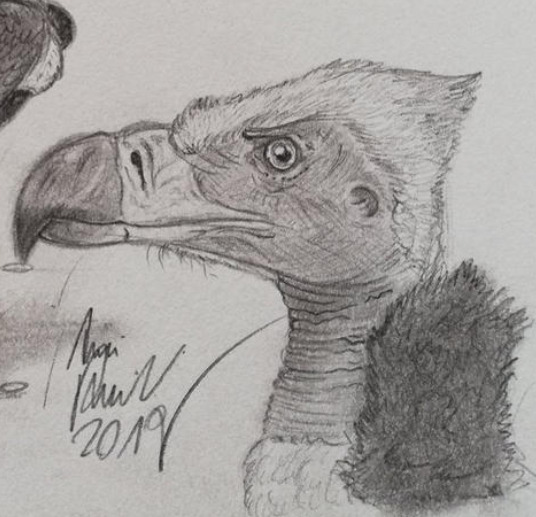

At the same time tho, despite being related to these vultures, Dynatoaetus didn't act like one. In this regard eagle is an appropriate term, more indicative of a lifestyle and morphology rather than relation (seeing as sea eagles relate to kites and philippine eagles are closer to these vultures than "real" eagles). With really robust hindlimbs and powerful talons, Dynatoaetus is more suited to capturing and incapacitating struggling live prey than it is to simply scavening dead bodies. And with Australia's megafauna offering a wide range of kangaroos, giant wombats and flightless birds it hat a lot to choose from.
Of course a bird of this size would not be above scavening either and with its power and bulk it could easily dominate carcasses when in conflict with the smaller Cryptogyps. Overall this lifestyle appears similar to what we see today in wedge-tailed eagles, which are formidable hunters but also opportunistic scavengers. Mather and colleagues even go as far as to suggest that the role of generalist apex predator was initially filled by Dynatoaetus and wedge-tails only managed to take up this nische after the former went extinct some 50k years ago along with most of Australias native fauna.
If you want an idea of things, here's some pictures of wedge-tailed eagles doing their thing. Now imagine what that would be like at twice the size.
images by Clive Roper and Scott Bell
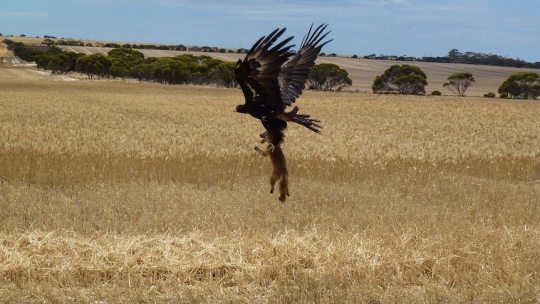

As per usual with these posts, here is the Wikipedia page I set up. Keep in mind the skeletal there shows the known material, but does not accurately represent the real proportions as its simply a colored griffon vulture. And the paper itself, its open access and gives more detail than I ever could.
Dynatoaetus - Wikipedia
A giant raptor (Aves: Accipitridae) from the Pleistocene of southern Australia | SpringerLink
And since you made it this far, here's a reward....or punishment? Idk depends but once I heard its name meant "mighty eagle" I couldn't get this goddamn clip out of my head and so you shall suffer with me.
#paleontology#palaeblr#eagle#birds of prey#vulture#Dynatoaetus#pleistocene#australia#giant eagle#fossil#prehistory#extinct animals#wedge tailed eagle
93 notes
·
View notes
Text
Vote for Annakacygna!
First off, it's a weird and enormous swan, which is pretty cool on its own, but more importantly, Vorombe is sadly not in the spirit of Dinosaur March Madness: Rising Stars. When it was most likely its own genus, Vorombe would have been a worthy contender, but given the paper indicating it may not be distinct from Aepyornis, this is no longer the case. This year's contest is meant to celebrate recent discoveries, and while a new and informative fossil of a preexisting bird is exciting, it just wouldn't be right for that to win the bird bracket over something truly distinct. I'd hate to have the top bird (or even DMM winner) need to have an asterisk by its name. I have hope that Heracles or Cryptogyps has a chance to defeat Vorombe in the next round, but it's not a guarantee. This is a humble request to consider this factor if you haven't already voted this round.
P.S.: If your reason to vote for Vorombe is that it reminds you of Harambe, I'm sorry, but I don't care for that joke in general and it's hardly a reason for a DMM vote
#annakacycna#vorombe#dinosaur march madness#dmm#a dinosaur a day#dmm rising stars#dinosaur#dinosaurs#my post
42 notes
·
View notes
Text
Round Three: Cryptogyps vs Heracles
Cryptogyps lacertosus

Artwork by @otussketching, written by @zygodactylus
Name Meaning: Powerful Hidden Vulture
Time: 770,000 to 55,000 years ago (Chibanian to Tarantian stage of the Pleistocene epoch, Quaternary period)
Location: Throughout Australia, including Kalamurina, the Wellington Caves, and the Nullarbor Plain
Today, there are no vultures in Australia. In fact, until recently, it seemed fairly clear that no vultures had lived in Australia - but now, we know they did! Originally thought to be an eagle, Cryptogyps was on the small size for a vulture, only bigger than the living Hooded Vulture - though it was about the size of the wedge-tailed eagle. However, it was proportioned similarly to other vultures, and between that and its great range across the entirety of Australia, it is logical to conclude that it lived similarly to other vultures, feeding primarily on carrion and going great distances to find it. It did not have the right musculature to be an active hunter like eagles and hawks. As such, Cryptogyps was a vital part of its environment, reducing the spread of disease and recycling nutrients and energy back into the food web like vultures today. Cryptogyps lived alongside a wide variety of weird megafuana present in Australia during the last ice age, including marsupial lions, giant demon-ducks (mihirungs), giant hippo-sized wombats, sheep-sized and fossorial echidnas, short-faced kangaroos, giant koalas, thylacines, giant maleefowls, huge monitor lizards, large crocodilians, and giant pythons - as well as cassowaries, regular kangaroos, emus, and other large animals that remain today. It was a weird place of which Cryptogyps was a small and important part, and would have been a regular sight in the skies to the first Indigenous Australians to settle on the continent!
Heracles inexpectatus

Artwork by @otussketching, written by @zygodactylus
Name Meaning: Unexpected Herculean Parrot
Time: 16 to 19 million years ago (Burdigalian stage of the Miocene epoch, Neogene period)
Location: St. Bathans Fauna, Bannockburn Formation, Aotearoa
Heracles was a truly alarmingly large parrot, related to modern day Kea, Kaka, and Kakapo, known from the fantastic avifauna of St Bathans. Standing more than two feet tall and weighing about fifteen pounds, this animal was much larger than any expected from the St Bathans fauna, which represented the initial colonization of Aotearoa (Zealandia) after it returned above sea level. Heracles is also the largest known species of parrot, ever. It was presumably flightless, though it is uncertain if it was nocturnal like its living relative the Kakapo. Its exact ecology is still uncertain, given the material known from Heracles is limited and its living relatives have very disparate ecologies, though it is possible it was omnivorous similar to the Kea and Kaka today. The St Bathans fauna lived in a freshwater lake system, in a subtropical emergent rainforest. Separated from land bridges, the fauna was dominated by birds, with early relatives of the Kiwi, New Zealand Wrens, Adzebills, and Wedge-Tailed eagles found in the fauna, as well as somewhat modern looking Moas. Smaller flamingos, large fruit pigeons, and a huge variety of geese and other waterfowl are known. In addition, frogs, tuataras, other lizards, crocodilians, turtles, and many different types of fish are known from this fascinating ecosystem.
#dmm#dmm rising stars#dinosaur march madness#dinosaurs#birds#paleontology#birblr#palaeoblr#march madness#bracket#polls#round three#cryptogyps#heracles
175 notes
·
View notes
Text
Aviraptor vs Cryptogyps


Factfiles:
Aviraptor longicrus

Artwork by @otussketching, written by @zygodactylus
Name Meaning: Long-legged Bird Thief
Time: 30 to 31 million years ago (Rupelian stage of the Oligocene epoch, Paleogene period)
Location: Jamna Dolna, Menilite Beds, Carpathian Flysch Zone, southeast Poland
Birds of prey are fascinating - there are many different kinds, doing many different things, and their radiation is poorly understood. Aviraptor helps put together some pieces of the puzzle by being the first raptor known adapted for eating birds as prey - essentially, capturing (larger) flying animals in the air, a not-easy feat. It was very similar to modern diurnal raptors, with a short beak, large laws, and long slender legs. That said, with those proportions it was very small - similar in size to living sparrowhawks and tiny hawks. It didn’t have a particularly hooked beak, but a straighter one similar to the harrier-hawks. It was similar, overall, to living birds that hunt early birds - and as such, it is the earliest known bird we know of to hunt other birds (oh bird on bird crime). Living alongside a variety of other birds, including passerines and hummingbirds, it probably fed on smaller avifauna in its area - and Aviraptor itself may have evolved in response to the radiation of many small birds in the early Oligocene. In addition to early modern-hummingbirds and crown passerines, Aviraptor lived alongside hoopoe-hornbill relatives, chickens, fish, and turtles.
Cryptogyps lacertosus

Artwork by @otussketching, written by @zygodactylus
Name Meaning: Powerful Hidden Vulture
Time: 770,000 to 55,000 years ago (Chibanian to Tarantian stage of the Pleistocene epoch, Quaternary period)
Location: Throughout Australia, including Kalamurina, the Wellington Caves, and the Nullarbor Plain
Today, there are no vultures in Australia. In fact, until recently, it seemed fairly clear that no vultures had lived in Australia - but now, we know they did! Originally thought to be an eagle, Cryptogyps was on the small size for a vulture, only bigger than the living Hooded Vulture - though it was about the size of the wedge-tailed eagle. However, it was proportioned similarly to other vultures, and between that and its great range across the entirety of Australia, it is logical to conclude that it lived similarly to other vultures, feeding primarily on carrion and going great distances to find it. It did not have the right musculature to be an active hunter like eagles and hawks. As such, Cryptogyps was a vital part of its environment, reducing the spread of disease and recycling nutrients and energy back into the food web like vultures today. Cryptogyps lived alongside a wide variety of weird megafuana present in Australia during the last ice age, including marsupial lions, giant demon-ducks (mihirungs), giant hippo-sized wombats, sheep-sized and fossorial echidnas, short-faced kangaroos, giant koalas, thylacines, giant maleefowls, huge monitor lizards, large crocodilians, and giant pythons - as well as cassowaries, regular kangaroos, emus, and other large animals that remain today. It was a weird place of which Cryptogyps was a small and important part, and would have been a regular sight in the skies to the first Indigenous Australians to settle on the continent!
DMM Round One Masterpost
#dmm#dinosaur march madness#dmm round one#dmm rising stars#palaeoblr#dinosaurs#paleontology#bracket#march madness#polls#aviraptor#cryptogyps
110 notes
·
View notes
Text
Round Two: Cryptogyps vs Miosurnia
Cryptogyps lacertosus
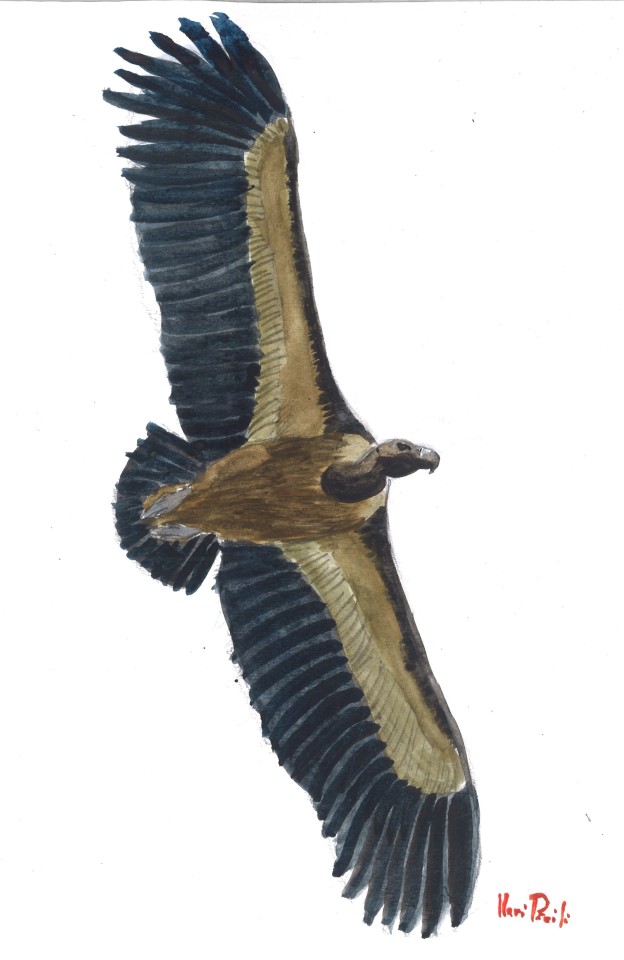
Artwork by @otussketching, written by @zygodactylus
Name Meaning: Powerful Hidden Vulture
Time: 770,000 to 55,000 years ago (Chibanian to Tarantian stage of the Pleistocene epoch, Quaternary period)
Location: Throughout Australia, including Kalamurina, the Wellington Caves, and the Nullarbor Plain
Today, there are no vultures in Australia. In fact, until recently, it seemed fairly clear that no vultures had lived in Australia - but now, we know they did! Originally thought to be an eagle, Cryptogyps was on the small size for a vulture, only bigger than the living Hooded Vulture - though it was about the size of the wedge-tailed eagle. However, it was proportioned similarly to other vultures, and between that and its great range across the entirety of Australia, it is logical to conclude that it lived similarly to other vultures, feeding primarily on carrion and going great distances to find it. It did not have the right musculature to be an active hunter like eagles and hawks. As such, Cryptogyps was a vital part of its environment, reducing the spread of disease and recycling nutrients and energy back into the food web like vultures today. Cryptogyps lived alongside a wide variety of weird megafuana present in Australia during the last ice age, including marsupial lions, giant demon-ducks (mihirungs), giant hippo-sized wombats, sheep-sized and fossorial echidnas, short-faced kangaroos, giant koalas, thylacines, giant maleefowls, huge monitor lizards, large crocodilians, and giant pythons - as well as cassowaries, regular kangaroos, emus, and other large animals that remain today. It was a weird place of which Cryptogyps was a small and important part, and would have been a regular sight in the skies to the first Indigenous Australians to settle on the continent!
Miosurnia diurna
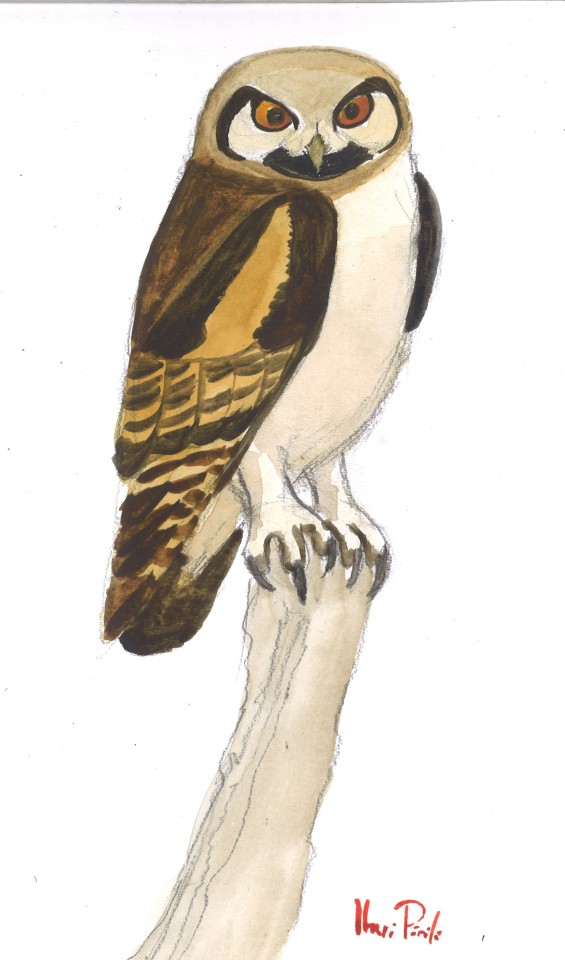
Artwork by @otussketching, written by @zygodactylus
Name Meaning: Diurnal Hawk-Owl from the Miocene
Time: 7.25 to 11.1 million years old (Tortonian stage of the Miocene epoch, Neogene period)
Location: Liushu Formation, Gansu Province, China
Miosurnia was a small owl, weighing around 318 grams and having a similar overall size to its living relatives, the modern hawk-owls. And, like its living relatives, Miosurnia was diurnal (based on its eye shape) - a rarity in owls, mainly seen in Hawk-Owls and putative early members of the group. As such, this small clade of diurnal owls has a longer and more extensive range than previously thought. If so, it may have eaten a variety of small diurnal mammals, similar to small kestrels in many habitats today. This allowed it to live alongside a wide variety of other avian predators, including many Old World Vultures and falcons. Like other diurnal owls, Miosurnia lived in a large open habitat, and this was one right after the great grassland explosion of the Miocene. As the polar ice sheets grew, these large open habitats expanded across the planet, greatly affecting many ecologies. In addition to other birds of prey, Miosurnia shared its habitat with Panraogallus, ostriches, sandgrouse, Ergilornithids, and many mammals such as Cahlicotheris, Gomphotheres, horses, giraffids, and buff hyenas.
#dmm rising stars#dmm#dinosaur march madness#dinosaurs#birds#palaeoblr#birblr#paleontology#bracket#march madness#polls#dmm round two#cryptogyps#miosurnia
117 notes
·
View notes
Text
DMM ROUND TWO MASTERPOST
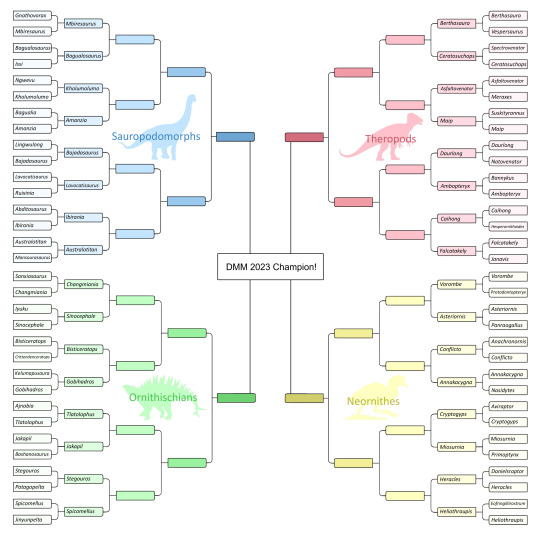
Ornithischians
Changmiania vs Sinocephale
Bisticeratops vs Gobihadros
Tlatolophus vs Jakapil
Stegouros vs Spicomellus
Sauropodomorphs
Mbiresaurus vs Bagualosaurus
Kholumalumo vs Amanzia
Bajadasaurus vs Lavocatisaurus
Ibirania vs Australotitan
Nonavian Theropods
Berthasaura vs Ceratosuchops
Asfaltovenator vs Maip
Daurlong vs Ambopteryx
Caihong vs Falcatakely
Avians (Neornithes)
Vorombe vs Asteriornis
Conflicto vs Annakacygna
Cryptogyps vs Miosurnia
Heracles vs Heliothraupis
REBLOG! SHARE! DEBATE!
IT'S DINOSAUR MARCH MADNESS!!!
#dmm#dinosaur march madness#dmm rising stars#dinosaurs#birds#dmm round two#dmm masterpost#paleontology#march madness#bracket#polls#birblr#palaeoblr
405 notes
·
View notes
Text
DMM ROUND THREE MASTER POST
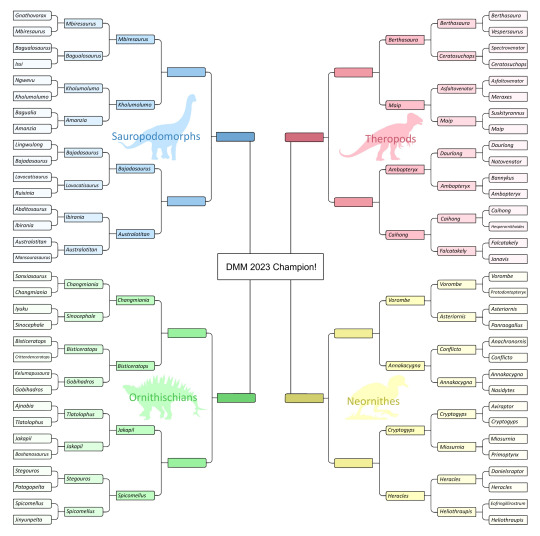
Ornithischians:
Changmiania vs Bisticeratops
Jakapil vs Spicomellus
Sauropodomorphs:
Mbiresaurus vs Kholumalumo
Bajadasaurus vs Australotitan
Non-neornithine Theropods:
Berthasaura vs Maip
Ambopteryx vs Caihong
Neornithes (Birds):
Vorombe vs Annakacygna
Cryptogyps vs Heracles
REBLOG! SHARE! DEBATE!
IT'S DINOSAUR MARCH MADNESS!!!
#dmm rising stars#dmm#dinosaur march madness#dinosaurs#birds#palaeoblr#birblr#paleontology#march madness#bracket#polls#round three
322 notes
·
View notes
Text
Finally made some progress on Wikipedia projects I've been sitting on for a bit.
After months in my sandbox I finished and published Basiloterus, an early whale from Pakistan
I managed to update Cryptogyps, an Australian vulture, using a 2023 paper
and with the same paper I also updated Dynatoaetus (its says a lot about extinct bird Wikipedia that nobody else could be arsed to add the newly described second species to the page)
12 notes
·
View notes
Text
Dynatoaetus gaffae Mather et al., 2023 (new genus and species)

(Foot bones of Dynatoaetus gaffae [scale bars = 10 mm], from Mather et al., 2023)
Meaning of name: Dynatoaetus = mighty eagle [in Greek]; gaffae = for Priscilla Gaff [program coordinator at the Melbourne Museum who studied Australian raptor fossils for her Master’s thesis]
Age: Pliocene?–Pleistocene (more precise age uncertain, but at least Chibanian)
Where found: Mairs Cave, Kutjitara Formation, and Victoria Fossil Cave, South Australia, Australia and Wellington Caves, New South Wales, Australia
How much is known: Partial skeleton of one individual, including a partial skull, some vertebrae, and various limb bones. Several isolated hindlimb bones have also been found.
Notes: Dynatoaetus was an accipitrid, or a “hawk” in the broad sense. It is the most completely known Pleistocene accipitrid from Australia and also one of the largest accipitrids ever found. Among predatory accipitrids, only the recently extinct Haast’s eagle (Hieraaetus moorei) of New Zealand and the Pleistocene Gigantohierax suarezi of Cuba were demonstrably larger.
The closest living relatives of Dynatoaetus appear to be the aegypiine vultures, a group that includes the cinereous (Aegypius monachus) and griffon vultures (Gyps fulvus). However, the robust proportions of its toe bones indicate that Dynatoaetus retained the typical accipitrid ability to hunt regularly and was not primarily a scavenger, unlike extant aegypiines. Its next closest living relatives are the circaetine eagles, which include a large predatory modern species, the Philippine eagle (Pithecophaga jefferyi). Considering how big Dynatoaetus was, it would have probably been able to prey on the young of the giant marsupials and flightless birds that it lived alongside. Like many modern eagles, however, it could have also scavenged opportunistically, and its size may have helped it intimidate other animals trying to feed from the same carcasses.
Along with the also recently-named Cryptogyps (an aegypiine that most likely had a more typical vulturine lifestyle), Dynatoaetus indicates that accipitrids once occupied a greater diversity of ecological niches in Australia than they do today. Whether predators or scavengers, large raptors like Dynatoaetus and Cryptogyps probably depended on megafauna as their main food source, so it is likely that they died out in the wake of the severe megafaunal extinctions that occurred in Australia during the Pleistocene.
Reference: Mather, E.K., M.S.Y. Lee, A.B. Camens, and T.H. Worthy. 2023. A giant raptor (Aves: Accipitridae) from the Pleistocene of southern Australia. Journal of Ornithology advance online publication. doi: 10.1007/s10336-023-02055-x
32 notes
·
View notes